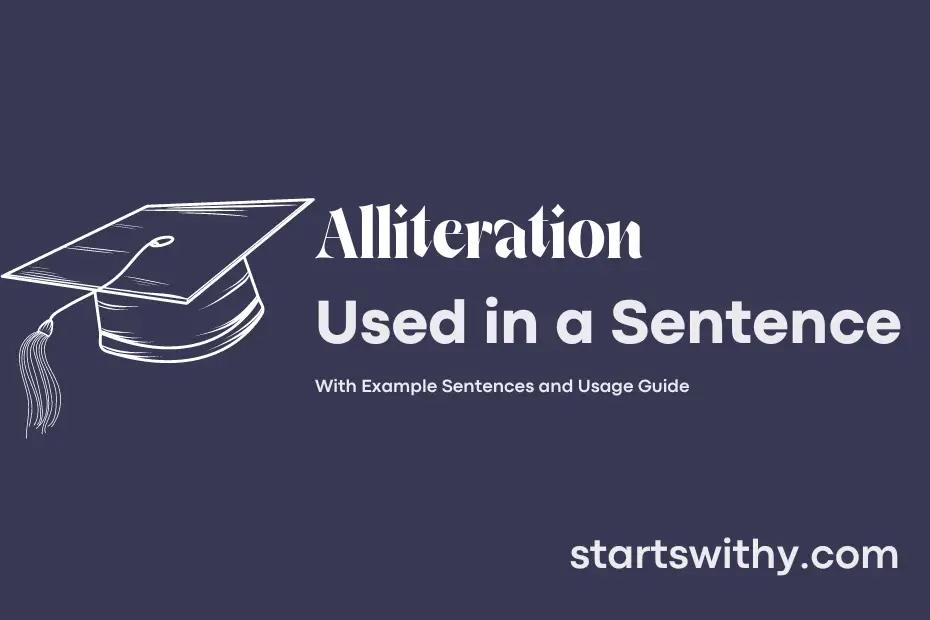Have you ever noticed the musical quality in sentences where words start with the same sound? This literary device is known as alliteration, a technique that adds rhythm and emphasis to written or spoken language.
By repeating initial consonant sounds, alliteration creates a memorable and harmonious effect in poetry, prose, and even advertising slogans. It can be a subtle touch that enhances the beauty of language or a powerful tool that drives home a message.
7 Examples Of Alliteration Used In a Sentence For Kids
- Big brown bear balances on a ball.
- Five funny frogs frolic in the pond.
- Happy horses hop in the field.
- Tiny turtles take a trip.
- Silly snakes slide on the sand.
- Cheerful children chase colorful butterflies.
- Playful puppies play with a pink ball.
14 Sentences with Alliteration Examples
- College students in India often enjoy attending animated art exhibitions.
- Physics professors provide plenty of practical projects for students to participate in.
- Students striving to secure scholarships should seek support from senior scholars.
- Many modern movies make meaningful messages more memorable for students.
- Exam time can be extremely exhausting for eager engineering enthusiasts.
- University updates urge undergraduates to utilize unique urban resources.
- Studying in silence significantly enhances student success in school.
- Attending additional academic activities can positively impact a student’s performance.
- Late-night library sessions are common among law learners looking to excel.
- Participating in peer problem-solving groups can help students handle high stress.
- Engaging in entrepreneurial endeavors early can enhance a student’s experience.
- Joining journalism journals can provide students with valuable writing opportunities.
- Students seeking success should stay strategic while selecting study subjects.
- Balancing books, buddies, and budgeting is vital for student survival in college.
How To Use Alliteration in Sentences?
Alliteration is a literary device that involves using words that begin with the same sound for effect in a sentence. It can create a pleasing rhythmic pattern and make the sentence more memorable and impactful.
Here’s a step-by-step guide on how to use alliteration in a sentence:
-
Choose a consonant sound: Select a consonant sound that you want to repeat throughout the sentence. For example, you might choose the sound “s” for a sentence like “Sally sells seashells by the seashore.”
-
Pick your words: Select words that start with the chosen consonant sound. Make sure the words fit naturally in the sentence and convey the meaning you want.
-
Craft your sentence: Arrange the words in a way that flows well and makes sense. Your sentence can be short or long, depending on your preference.
-
Revise if needed: Read the sentence aloud to see if the repetition of sounds creates the desired effect. Make adjustments to the words or structure as needed.
-
Practice: Experiment with different words and sounds to become more comfortable with using alliteration in your writing. The more you practice, the more proficient you will become at using this literary device effectively.
Remember, the key to using alliteration successfully is to strike a balance between creativity and clarity. Have fun with it and don’t be afraid to play around with different words and sounds to create unique and engaging sentences.
Conclusion
In conclusion, using alliteration in sentences can make them more engaging and memorable. By repeating initial sounds, alliteration creates a rhythmic quality that can draw in readers or listeners. Examples like “Sally sells seashells by the seashore” demonstrate how alliteration can add a playful or melodic tone to language.
Not only can alliteration enhance the aesthetic appeal of writing, but it can also help emphasize a point or make information more easily retained. Whether used in poetry, advertisements, speeches, or everyday conversation, alliteration can be a powerful tool for enhancing communication. Its ability to add flair and emphasis to language makes it a valuable technique for writers looking to make their sentences more impactful.



